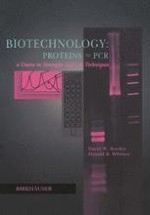1995 | OriginalPaper | Buchkapitel
Screening for Clones
verfasst von : David W. Burden, Donald B. Whitney
Erschienen in: BiotechnologyProteins to PCR
Verlag: Birkhäuser Boston
Enthalten in: Professional Book Archive
Aktivieren Sie unsere intelligente Suche, um passende Fachinhalte oder Patente zu finden.
Wählen Sie Textabschnitte aus um mit Künstlicher Intelligenz passenden Patente zu finden. powered by
Markieren Sie Textabschnitte, um KI-gestützt weitere passende Inhalte zu finden. powered by
Once E. coli is transformed with a ligation mixture, the task of identifying the desired clone follows. Depending on the DNA source, tens to hundreds of thousands of clones may be screened before the target is identified. As we explored in Chapter 7, the strategy used in the cloning process will determine the amount of work required to identify that clone.Cloning strategies usually include the use of probes to search E. coli. These probes may be oligonucleotides derived from the amino acid sequence of a protein, a closely related gene cloned from a different species, or cDNA synthesized from the same species. Regardless of the origin, probes have the common feature of being homologous to, and thus being able to hybridize with, the targeted gene. Probes labelled with a radioactive tag or with an antigen can be used to rapidly screen thousands of clones to identify the desired gene.The isolation, fragmentation, and ligation of DNA, and the subsequent transformation of E. coli were all steps necessary to generate a large population of random clones. The objective of this chapter is to provide you with the techniques needed to screen these random clones in order to find the MEL1 gene. The laboratory section of this chapter will involve synthesizing a labelled probe, testing the probe, and applying that probe to screen E. coli colonies harboring recombinant DNA.
